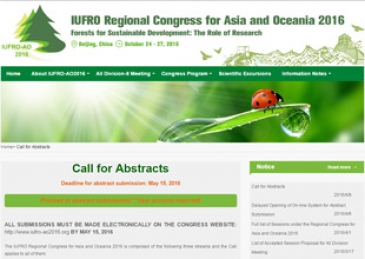IUFRO Regional Congress for Asia and Oceania 2016
Asia and Oceania encompass only about one-quarter of the world's land area, but provide home to more than one-half of the world's population. Some of the world's richest and many of its poorest countries are located in the region. Some countries have almost no forests, while others have more than two-thirds of their land covered by forest vegetation. Furthermore, the region includes both both some of the world's leading importers and exporters of forest products.
Most countries in this region have experienced extremely rapid social and economic developments and forest changes in recent years. While forest resources have helped to fuel the surging economic development, forests have also suffered greatly from the rapid changes such as deforestation and forest degradation. Expanding populations and greater wealth have led to an increasing demand for wood products and non-timber products, farmland, water resources, electricity from hydro-electric sources, and attractive industrial and residential sites. At the same time, there are urgent needs for the conservation of biological diversity, protection of water and soils, forest-based recreation and ecotourism, and carbon sequestration for mitigating climate change. Across the region, while highly encouraging progress has been made by some countries in moving towards green economies, the transition to more open and flexible market economies has also brought new risks and threats to forest resources, and new resource management regime reforms. Other countries have experienced a privatization trend (e.g., the privatization of most of New Zealand's forest plantations). Meanwhile, reducing deforestation and forest degradation and combating illegal logging form an increasingly important obligation shared by all countries in this region.
The region is also increasingly affected by global climate change, and especially in recent years it has suffered from a series of natural catastrophes due to extreme weathers, such as the disastrous 2008 ice-storm in China, the 2015 Myanmar floods, frequent typhoons affecting Southeast Asia, and prolonged droughts threatening western, central and northeastern Asia, Australia and New Zealand. Meanwhile, the region is also facing threats by geological hazards and other complex (geological, meteorological) disasters, such as the 2004 Indonesia tsunami, the 2011 Japan earthquake and tsunami with subsequent nuclear accident, and the 2015 Nepal earthquake and consequent landslides. These disasters have not only destroyed lives, properties and the environment, but have also robbed those who survived of their homelands. Consequences of natural calamities have been particularly severe for the many victims of natural calamities who live in rural mountainous areas. Therefore, research on multipurpose forestry development, forestry mitigation and adaption to climate change is urgently needed. Similarly, research on restoring biodiversity and rehabilitating degraded forest ecosystems to enhance forest ecosystem services across scales to improve rural mountainous people’s livelihoods and living environment, and promote green economies, is an absolute necessity.
The IUFRO Regional Congress for Asia and Oceania 2016 aims at reaching a common understanding about the status and trends of forests and the consequent research needs towards sustainable forestry development under such changes. It also aims at generating research synergies for well-informed policy and decision making to meet the forest governance and management demands in the transition period.



